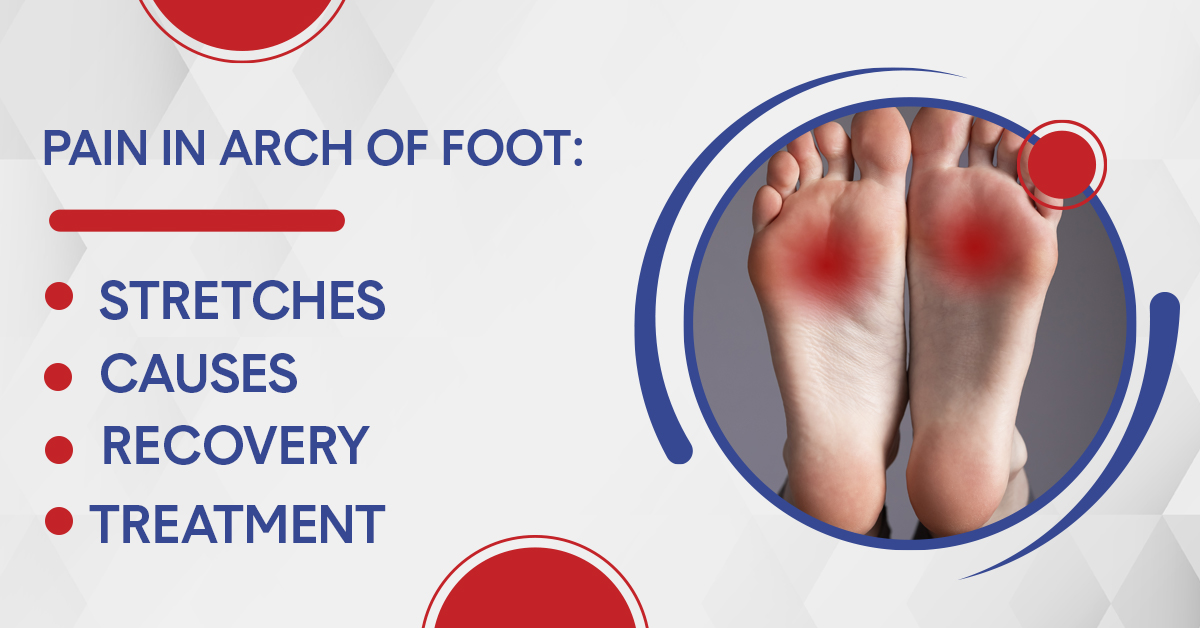Pain in the arch of the foot can be caused by several factors. There are several causes of plantar fasciitis, including posterior tibial tendon dysfunction, cavus foot, and more.
A person who has arch pain has symptoms that occur under the arch of their foot. Usually, patients who suffer from arch pain have inflammation of their midfoot soft tissues. Known as the plantar fascia, the arch of the foot is formed by tight bands of tissue that connect the heel bone to the toes.
Using this band of tissue helps transfer weight from the heel to the toes and maintain proper foot mechanics. It can be quite painful to move your foot when the arch tissue becomes inflamed and irritated.
Ball and heel pain are common symptoms of arch pain. A person might also experience pain in the top of their foot, or their ankles, knees, hips, legs, and back. Walking, standing, or activities involving your feet may cause the pain to be worse, depending on the underlying cause. You may also experience more intense symptoms in the morning.
Causes of Arch Foot Pain:
Because the arch is comprised of many different structures, sore foot arches may be caused by one or a combination of different foot conditions. The following conditions can cause arch pain, for example:
- Plantar Fasciitis
- Peroneal Tendonitis
- Tibialis Posterior Tendonitis
In addition to having distinct symptoms, each of these conditions may also overlap. It is also possible that they have a common cause or are triggered by different factors.
As a result, your podiatrist would have received university training in both foot anatomy and how the arch can be injured to determine the most likely cause of arch pain.
You can Read Also: Ulcerative Colitis (UC): Symptoms, Causes, Diagnosis and Treatment
There are many causes of arch pain, including damage to bones and joints, strained ligaments and tendons, overextended muscles, and even irritated nerves. Many factors can lead to the injury of these structures.
Injuries that occur suddenly, such as landing awkwardly after jumping, can strain muscles and ligaments and jar the bone structure. It is also possible in some cases that the arch becomes chronically strained because of the way the foot works.
The ligament that supports the arch can be strained in both collapsed/fallen arches and high arches. When the foot doesn’t work well, some of the small muscles in the foot can become overworked and strained. Nerve irritation may cause a sore foot arch by shooting pains or causing a burning sensation.
Diagnosis of Pain in Arch of Foot:
Several questions will be asked by the doctor to determine the cause of the problem. When discussing pain with a physician, make sure to explain how and when it started, how it affects you, when it bothers you, and what you may have done to make the pain worse or better.
To determine whether any other injuries have occurred, a thorough physical examination can be conducted.
- During a physical and visual examination, the medical professional will move the feet while wearing weight-bearing and non-weight-bearing shoes.
- It is necessary to inspect the foot and arch to determine if there are any obvious deformities, swellings, tender spots, or bone differences.
- An examination of your foot’s muscles will be conducted by a medical professional. Depending on the test, you may be asked to hold or move your foot and ankle against resistance. You may also be asked to stand, walk, or run.
- There will be an examination of the skin to check for signs of bruising, breaks, or infections.
- To ensure no injury has occurred in the foot, the nerves will be tested.
- For the assessment of bone and soft tissue abnormalities in the foot and arch, X-rays, MRIs, or bone scans may be used.
- Several systemic diseases, including rheumatoid arthritis, gout, and diabetes, can be ruled out with a blood test.
How should you go to Doctor?
There is usually no cause for concern with occasional arch pain. Depending on the situation, you may be able to find relief with home remedies, such as soaking your foot, getting a massage, or resting your feet.
Talk to your doctor if you experience pain frequently, or if home remedies don’t improve your pain. The pain in your arches can progress to more serious foot conditions, which may even affect your knees, back, and ankles. It’s especially important to stay on top of foot injuries or pains if you have diabetes.
Home Remedies for pain in the arch of the foot:
To alleviate pain, an individual should still use home remedies and stretches while undergoing treatment. When a doctor advises against moving the foot, one shouldn’t attempt these exercises.
Here are some home remedies that can reduce back pain include:
- Resting: If you are doing anything that aggravates the arch, you should stop or significantly reduce it.
- Applying ice: Ice packs wrapped in a cloth can be applied to tender areas of the arch to reduce swelling.
- Wearing socks: Avoid walking barefoot, wearing socks is advisable.
- Using support: Use cushions, inserts, and support shoes to alleviate pain.
- Splinting: To keep your foot supported while sleeping, ask a doctor about wearing a splint.
- Using medication: Pain relief medications such as ibuprofen are available over-the-counter.
A person can also relieve pain and reduce the chances of injury by using a few different techniques. The following are among them:
Foot Stretch-
By performing this stretch, follow these instructions:
- Sit back down.
- The other thigh should place on the foot.
- With one hand, hold the toes while using the other to press down and in on the heel.
- For three to five minutes, slowly press the toes toward the heel.
Read Also: Become a Sports Medicine Orthopedic Surgeon
Calf Stretch-
One can ease discomfort and strain on the foot’s arch by stretching their calves.
By performing this calf stretch, follow these instructions:
- Place both hands on the wall, shoulder-width apart, while facing the wall.
- Step backward with one foot.
- While keeping the rear knee straight and the heel on the ground, bend the front knee.
- Repeat three repetitions while holding the stretch for 20–30 seconds each time, then switch legs.
Roller or ball foot massage-
For a foot massage stretch, a person can use a tennis ball or a tiny foam roller. Sitting is the best position to use this method in.
By performing this stretch, follow these instructions:
- Sit in a chair after taking off your shoes.
- Put the ball or roller under your foot’s arch.
- From the ball of the foot to the heel, roll it back and forth over the arch.
Medical Treatment for pain in the arch of the foot-
In most cases of plantar fasciitis, people recover within several months after using conservative treatment methods, such as icing, stretching, and modifying or avoiding painful activities.
Medications-
There are a variety of pain relievers available for the treatment of plantar fasciitis, including ibuprofen (Advil, Motrin IB, others) and naproxen sodium (Aleve).
Therapies-
Symptoms might be relieved by physical therapy or special devices.
- Physical therapy. Physical therapists can teach you exercises to strengthen lower leg muscles and stretch the plantar fascia. To support the bottom of your foot, a therapist might also suggest applying the athletic tape.
- Night splints. It may be necessary for your physical therapist or doctor to recommend that you wear a splint overnight to promote stretching of your plantar fascia and Achilles tendon.
- For an even distribution of pressure on your feet, your health care provider may prescribe off-the-shelf or custom-fitted arch supports (orthotics).
- Walking boots, canes, or crutches. Depending on your health care provider, you might need one of these for a short period to keep your foot from moving or to keep your feet from being fully loaded.
Surgical or other procedures-
After a few months, if additional cautious methods are still ineffective, your doctor can advise:
- It may be possible to temporarily relieve pain by injecting a steroid medication into the tender area. If you get multiple shots, you run the risk of weakening your plantar fascia and possibly causing it to rupture. Injected platelet-rich plasma from your blood can promote tissue healing in tender areas. Precision needle placement can be assisted by ultrasound imaging during injections.
- Extracorporeal shock wave therapy. Healing is stimulated by sound waves directed at the heel pain area. In this case, more conservative treatments have failed to resolve chronic plantar fasciitis. Although this therapy isn’t consistently effective, some studies indicate promising results.
- Ultrasonic tissue repair. A needle-like probe is guided into the damaged plantar fascia tissue using ultrasound imaging. After the damaged tissue is broken up from the probe tip, it is suctioned out with the aid of a suction device.
- The plantar fascia may usually be separated from the heel bone without surgery. It is typically only a possibility when other therapies have failed and the pain is extremely bad. Open surgery or a minor incision with a local anesthetic are both options.
Complications of pain in the arch of the foot:
It is crucial to receive a good diagnosis and adhere to suggested treatment if a person has foot arch discomfort. If the discomfort continues without treatment, problems can develop.
A flattening of the arch over time, which increases strain, as well as the loss of the fat pad surrounding the ball or heel of the foot are two examples of complications of plantar fasciitis.
A degeneration in the surrounding joints, which can result in foot deformity, is one potential complication of PTTD.
If athletic injury or overuse is the cause of arch pain, improper rest and rehabilitation may lead to greater discomfort in other areas of the foot or leg.
Arches Of Foot And Its Effect On Body-
At the bottom of the foot, two different types of arches are created by the tarsal and metatarsal bones. The transverse and longitudinal arches are what we refer to as these. These arches support the body by acting as springs.
Additionally, a person’s posture is influenced by the arch of their foot. Medial, lateral, and basic longitudinal arches are further categories for longitudinal arches. The type of injuries a person is vulnerable to can also be determined by how much their feet arch.
Low Arch-
A person is also referred to as flat-footed if their feet have a little arch. Around the world, up to 20% of people have flat feet. Low arches make feet extremely flexible and raise the chance that the foot will slide inward.
A greater risk of heel discomfort, plantar fasciitis, heel spurs, bunions, and arch pain exists in people with low arched feet. Additionally, it can raise the possibility of medial knee issues. Rearfoot posting and arch support can help the foot align and control over-pronation.
Medium Arch-
Here’s an illustration of a biomechanically effective foot. It has a distinct arch and a foot that is only slightly flexible. Metatarsalgia and heel pain is the most typical foot issues that these folks are prone to.
The wearing of the wrong shoes causes this. People with feet that have a medium arch should make sure that the shoes they wear are the right size.
The best shoes for someone with a medium arch have additional cushioning, and adequate support and they effectively absorb shock. This can aid in maintaining good body alignment and injury prevention.
High Arch-
A well-defined arch that protrudes higher from the ground than the typical foot is referred to as having a high arch. With this kind of arch, the foot becomes extremely inflexible and the forefoot and back foot are subjected to additional stress.
Up to 20 percent of people worldwide could be impacted by this. When walking or running, those with high arches have a relatively little surface area to cushion the impact.
Due to this, they may be more prone to plantar fasciitis, forefoot pain, and heel pain. In addition, it can make calluses, arch strain, heel pain syndrome, and claw toes more likely.


